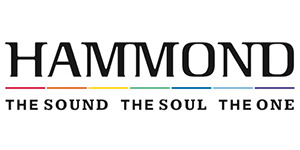The Viscount Legend is a professional two-manual digital tonewheel organ that authentically recreates the iconic sound and feel of classic electromechanical tonewheel organs through Viscount's advanced TMT (Tonewheel Modeling Technology). This innovative physical modeling synthesis technology accounts for every nuance that influences the sound of vintage organs, including perfect tonewheel synchronization, imperfect electrical circuits, motor noise, and the characteristic mechanical artifacts that define the classic Hammond sound.
Authentic Drawbar Configuration
The Legend features a comprehensive complement of 38 drawbars organized into five groups:
- Upper Manual: Two complete sets (A & B) of 9 drawbars each
- Lower Manual: Two complete sets (A & B) of 9 drawbars each
- Pedalboard: 2 dedicated drawbars (compatible with optional Viscount pedalboard or any MIDI pedalboard)
When no pedalboard is connected, the pedal drawbars can be played using the first two octaves of the lower manual. Both manuals feature inverted-color keys on the first octave (Black Octave) for intuitive selection between the two drawbar sets or nine user-editable presets per manual.
Professional Waterfall Keyboards
The instrument is equipped with two professional-grade 61-note waterfall keyboards that deliver authentic organ playing feel—far superior to synthesizer or portable keyboard action. These heavy-duty keyboards are built for serious performance and provide the tactile response organists expect.
Comprehensive Tonal Control
Upper Manual Controls:
- Volume with Normal/Soft quick-select
- Reverb level
- Drive (overdrive/distortion) level
- Keyclick level adjustment
- Fine tuning trimmer
- Crosstalk level adjustment
- Three-band EQ (Bass, Middle, Treble)
- Pedals sustain control
- Percussion envelope controls (Decay, Volume)
Lower Manual Controls:
- Reverb routing (Post/Pre) and type (Hall/Spring)
- Drive type (Classic/Rock)
- Tonewheel model selection ('30s, '50s, '70s)
- Transpose function
- Rotary speaker controls (Direct, Classic/Rock listening mode)
- Hold pedal mode (Internal/External)
- Pedals routing (Direct, To Lower)
Vibrato and Chorus Effects
The Legend provides independent Vibrato/Chorus assignment for upper and lower manuals with the classic rotary selector offering six distinct modulation types:
- Vibrato: V1, V2, V3 (varying modulation depths)
- Chorus: C1, C2, C3 (varying modulation depths)
Each manual can be switched on/off independently for maximum tonal flexibility.
Percussion System
Faithful to the original tonewheel organ design, the Legend's percussion system features:
- Rocker tab activation (On/Off)
- Volume control (Soft/Normal with dedicated volume pot)
- Decay time selection (Slow/Fast with dedicated decay pot)
- Harmonic selector (2nd/3rd harmonic)
- Active only when drawbar Set B is selected
- Automatically mutes the 1' drawbar when engaged (authentic behavior)
Rotary Speaker Simulation and Control
The instrument includes sophisticated rotary speaker simulation with:
- Three-position lever control (Brake/Slow/Fast)
- Listening mode selection (Classic: as perceived by player / Rock: as recorded by microphone)
- Direct mode for bypassing internal rotary effect
- 11-pin connector for controlling external Leslie speakers
- Optional foot pedal control
- "Memphis Style" mode (simulates disconnected woofer motor for constant bass with modulated treble)
Tonewheel Models
Six authentic tonewheel organ models spanning different eras:
- '30s Model: Classic 1930s sound without 16' foldback
- '50s Model: Quintessential jazz organ sound from the 1950s-60s
- '70s Model: Progressive rock and pop sound
- BC Model 1936: Specific vintage instrument clone
- B3 Model 1956: Specific vintage instrument clone
- A100 Model 1961: Specific vintage instrument clone
JDF Signature Edition features three additional models cloned from Joey DeFrancesco's personal collection of tonewheel organs, personally voiced by Joey himself.
Effects Processing
Reverb:
- Type selection: Hall (natural room) or Spring (mechanical spring reverb)
- Routing: Pre or Post rotary speaker in signal chain
- Continuously variable level control
Drive:
- Classic mode: Tube amplifier overdrive from vintage Leslie cabinets
- Rock mode: Sharper 1970s guitar amplifier-style distortion
- Continuously variable amount control
- Dynamic response based on drawbar settings, expression pedal position, and number of notes played
Authentic Mechanical Noise Simulation
To complete the vintage experience, the Legend recreates the characteristic "defects" that became part of the classic tonewheel sound:
- Keyclick: Adjustable contact switch noise at note attack
- Crosstalk: Adjustable electromagnetic interference between internal audio cables
Black Octave and Preset System
Each manual features a "Black Octave" (inverted-color first octave) providing:
- Direct access to 9 user-editable presets (C# through A keys)
- Drawbar Set A/B selection (A# and B keys)
- Cancel function (C key) for Local Off/Master Keyboard mode
- Factory presets based on classic organ registrations (Cello, Flute & Strings, Clarinet, Full Great, etc.)
Gospel Set Function
For Gospel musicians, the Legend offers an invertible drawbar layout option, placing lower manual drawbars on the left side (traditionally on the right) for more comfortable single-handed playing on the lower manual.
Comprehensive Connectivity
Audio Outputs:
- Stereo line outputs (Left/Right) - 1/4" jack
- Dedicated pedal output (when in Direct mode)
- Effect send/return loop (FX Send/Return)
- Analog input with gain control
- 11-pin rotary speaker output
- Front and rear headphone outputs
MIDI Implementation:
- MIDI In, Thru, Out 1, Out 2 (5-pin DIN)
- Dedicated Pedals Keyboard Only input (optimized for pedalboard connection)
- USB-MIDI (USB to Host) for computer connectivity






